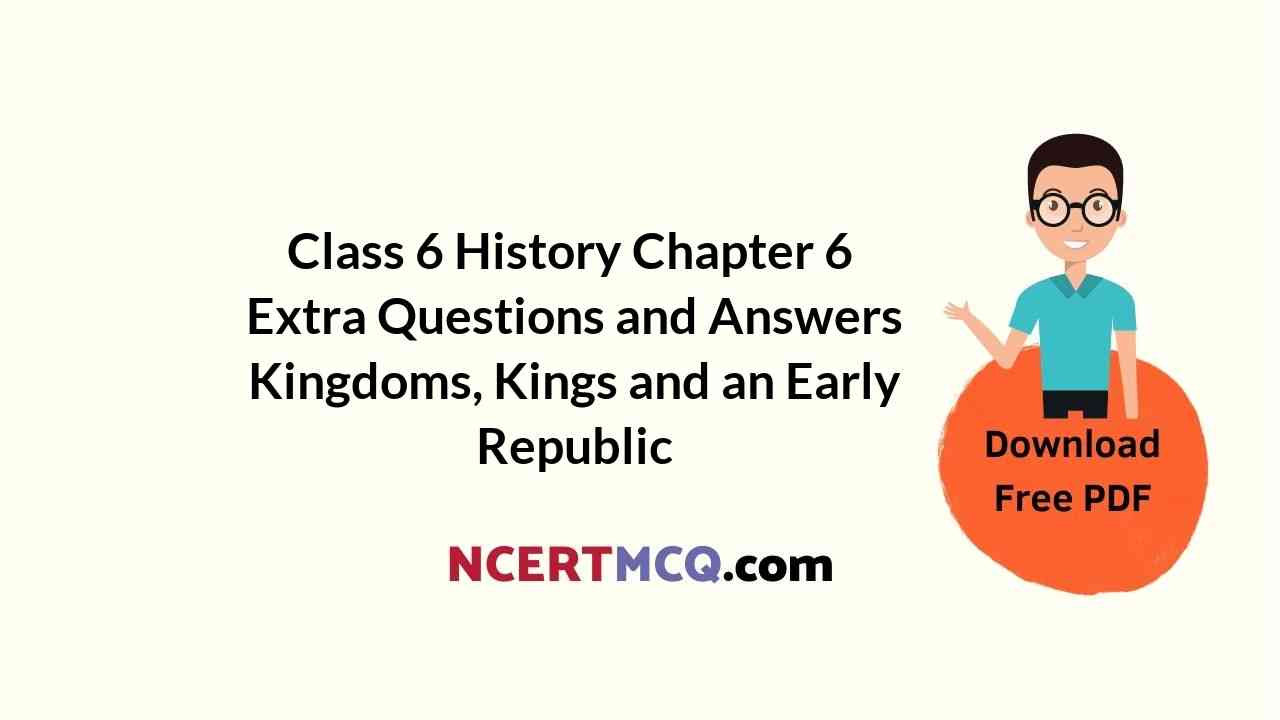Here we are providing Online Education for Class 6 History Chapter 6 Extra Questions and Answers Kingdoms, Kings and an Early Republic was designed by subject expert teachers. https://ncertmcq.com/extra-questions-for-class-6-social-science/
Online Education for Kingdoms, Kings and an Early Republic Class 6 Extra Questions History Chapter 6
Class 6 History Chapter 6 Extra Questions And Answers Question 1.
How were the rajas chosen in the early times? How were they chosen by about 3000 years?
Answer:
Some of the rajas in the early times were chosen by the Jana, the people about 3000 years ago some changes took place in the way rajas were chosen. Some men come become recognised as rajas by performing very big sacrifices.
Kingdoms Kings And An Early Republic Extra Questions And Answers Question 2.
What was the Ashvamedha sacrifice?
Answer:
It was a horse sacrifice, performed by a ruler after the other rajas had accepted his supremacy and authority.
Ncert Class 6 History Chapter 6 Extra Questions Question 3.
What was the later Vedic literature?
Answer:
Many books were composed in northern India, especially in the areas drained by the rivers Ganga and Yamuna. These books were called later Vedic literature because they were composed after the Rigveda.
![]()
Kingdoms, Kings And An Early Republic Extra Questions And Answers Question 4.
Name the Vedas composed after the Rigveda. What did they contain?
Answer:
The Vedas composed after the Rigveda were Samaveda, Yajurveda, ATarveda, They were composed by the priests and described how rituals were to be performed.
Class 6 History Ch 6 Extra Questions Question 5.
Name the different groups of people in the society about 3000 years ago.
Answer:
The different groups of people in die society at this tune were priests and warriors, farmers, herders, traders, craftspersons, labourers, fishing folk and forest people.
Chapter 6 History Class 6 Extra Questions Question 6.
What are janapadas?
Answer:
The word janapada means the land where the Jana sets its foot and settle down. The rajas who performed big sacrifices were recognised as the rajas of the janapadas.
![]()
Class 6 History Chapter 6 Extra Questions Question 7.
What is painted grey ware?
Answer:
Painted grey ware was a specially kind of pottery, which had painted designs, usually simple lines and geometric patterns. Plates and bowls were the most common vessels made. They are extremely fine to touch, with a smooth surface. They were used on special occasions to serve food.
Class 6 History Chapter 6 Question Answer Question 8.
How was the ceremony performed by the ruler after the horse returned successfully?
Answer:
The raja was the central figure in the ceremony. He often had a special seat, a throne or a tiger skin. His charioteer, who was his companion on the battlefield and witnessed his exploits related his exploits. The wives and relatives performed minor rituals. The other rulers are simply spectators. Priests perform the various rituals, including sprinkling of sacred water.
Class 6th History Chapter 6 Extra Questions Question 9.
How were the varnas determined? Write about them.
Answer:
Varnas were determined on the basis of birth e.g. if one’s father and mother were Brahmins, one could automatically become a Brahmin and so on. later they classified some people as untouchables. They included crafts persons, hunters and gatherers. The priests said that the contact with these groups was polluting in.
Kingdoms Kings And An Early Republic Questions And Answers Question 10.
How was the Ashwamedha sacrificed performed? Why?
Answer:
In the Ashwamedha sacrifice, the horse was let loose to wander freely and it was guarded by rajas men. If the horse wandered into the territory of other rajas and they stopped it, they had to fight. If they allowed the horse to pass, it meant that they accepted that the raja who wanted to perform the sacrifice was stranger than them. The rajas were invited to the sacrifice, which was performed by specially trained priests. The raja who organised the sacrifice was recognised as being very powerful, and all those who came brought gifts for him.
![]()
Multiple Choice Questions
1. Why did the raja perform Ashvamedha?
(a) To show victory
(b) To please his citizens
(c) To show his supremacy
(d) To please almighty
Answer:
(c) To show his supremacy.
2. Who was the central figure in Ashvamedha ritual?
(a) The minister
(b) The head of the army
(c) The main priest
(d) The raja
Answer:
(d) The raja.
3. Who were excluded from many rituals of Ashvamedha?
(a) Shudras
(b) Priests
(c) Ministers
(d) Vaishyas
Answer:
(a) Shudras.
![]()
4. Which of the following is the later Vedic book?
(a) The Samveda
(b) The Yajurveda
(c) The Atharvaveda
(d) All of these
Answer:
(d) All of these.
5. Which one of the area of the sub-continent where social and economic differences were not very sharp?
(a) The north-east region
(b) The north-west region
(c) The south-east region
(d) The southwest region.
Answer:
(a) The northeast region.
6. Name those settlements in the Janapadas which archaeologists have excavated?
(a) Purana Qila in Delhi
(b) Hastinapur near Meerut
(c) Atranjikhera near Etah
(d) All of these
Answer:
(d) All of these.
7. The rajas in Jana padas made payments in …………………….. .
(a) paper notes
(b) coins
(c) cheques
(d) all of these
Answer:
(b) coins.
![]()
8. In mahajana padas, taxes on crops was fixed at ……………………………… .
(a) 1/3rd of what was produced
(b) 1/4th of what was produced
(c) 1/5th of what was produced
(d) 1/6th of what was produced
Answer:
(d) 1/6th of what was produced.
9. Which of the following was the major change in agriculture in mahajanapada period?
(a) Use of iron ploughshares
(b) Transplanting paddy
(c) Both (a) and (b)
(d) None of these
Answer:
(c) Both (a) and (b).
